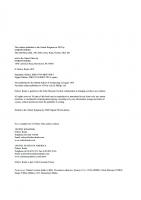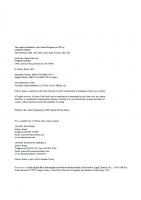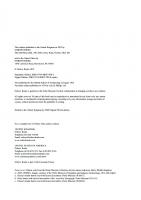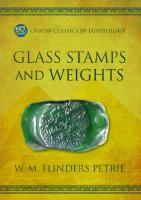Naqada and Ballas (Oxbow Classics in Egyptology) 9798888570203, 9798888570210
183 18 61MB
English Pages [182]
Cover
Book Title
Copyright
Contents
List of Plates
Note on Plates
INTRODUCTION. (P.)
i. The site of work
ii. Organisation of work
iii. The record of results
iv. Assistance in England
PREFACE TO THE 2023 EDITION
PUBLISHER’S PREFACE
CHAPTER I. (Q.) THE CEMETERIES OF BALLAS.
1. Around Deir
2. Work at Ballas
3. The North Town
4. Burials in North Town
5. Mastabas of IVth–VIth dynasties
6. Contracted burials of IVth dynasty
7. Staircase tombs
CHAPTER II. (Q.) SELECTED EGYPTIAN TOMBS, BALLAS.
8. Details of staircase tombs, IVth dynasty
9. Details of well tombs, IVth dynasty
10. Burials in earth, IVth dynasty
11. Façade tombs, XIIth dynasty
12. Inscription of Tahuti, XIIIth dynasty
CHAPTER III. (Q.) PRODUCTS OF THE NEW RACE, BALLAS.
13. Discovery of the graves
14. The course of excavation
15. Mutilation of the bodies
16. Arrangement of graves
17. Slate palettes
18. Toilet objects
19. Stone vases
20. Pottery making
21. Incised marks
22. The rough pottery
23. Wavy-handled vases
24. Red and black pottery
25. Decorated pottery
26. Late pottery
27. Incised and white-painted pottery
28. Positions of pottery
29. Human figures
30. The game
31. Ivory and maces
32. Copper objects
33. Lamps
CHAPTER IV. (Q.) SELECTED GRAVES OF THE NEW RACE, BALLAS.
34. Graves drawn, Pls. III–V
35. Graves not drawn
CHAPTER V. (Q.) SUMMARY OF BALLAS.
36. Date of foreign burials
37. Summary of burials found
CHAPTER VI. (P.) CEMETERY OF THE NEW RACE, NAQADA. THE DRAWN GRAVES.
38. Nature of Graves
39. Graves with coffin, T. 4
40. Graves with scooped bones, T. 5
41. Graves T. 14 to No. I. 263
42. Grave 271, ivory figures
43. Graves 283–880
CHAPTER VII. (P.) NOTABLE GRAVES, NAQADA.
44. Graves in B. cemetery
45. Graves in T. cemetery
46. Graves 1 to 286
47. Graves 326 to 878
48. Graves 1037 to 1488
49. Graves 1507 to 1918
50. Positions of objects
CHAPTER VIII. (P.) DETAILS OF BURIALS, NAQADA.
51. General system of burials
52. Treatment of skulls
53. Treatment of bodies
54. Anthropophagy indicated
55. Untenable suggestions
CHAPTER IX. (P. & Q.) DESCRIPTION OF PLATES.
56. Maps, Pls. I, I A
57. Figures and games, Pls. VI, VII
58. Stone vases, Pls. VIII–XVII
59. Local pottery, Pls. XVIII–XXIX
60. Imported pottery, Pls. XXX–XXXVI
61. Rough and later pottery, Pls. XXXVII–XLIII
62. Egyptian pottery, Pls. XLIV–XLVI
63. Slate palettes, Pls. XLVII–L
64. Marks on pottery, Pls. LI–LVII
65. Beads, etc., Pl. LVIII
66. Human figures, Pl. LIX
67. Animal figures, Pl. LX
68. Ivory carvings, Pls. LXI–LXIV
69. Implements of copper, etc., Pl. LXV
70. Paintings on pottery, Pls. LXVI, LXVII
71. Palaeolithic flints, Pls. LXVIII, LXXVI
72. Nile gravel flints, Pls. LXIX, LXXVI
73. Ballas desert flints, Pl. LXX
74. New Race Town flints, Pl. LXXI
75. New Race grave flints, Pl. LXXII–LXXVI
76. Stone implements, Pl. LXXV
77. Ivory handle, and lintel of Tahutmes I, Pl. LXXVII
78. Skulls of New Race, capacities, Pl. LXXXIV
79. Female small skulls
80. Length and breadth ratio
81. Prognathous ratio
82. Algerian dolmen skulls
83. Relation of New Race to Algerian skulls
84. Nubt and Southern Town plan, Pl. LXXXV
85. The great cemetery plan, Pl. LXXXVI
86. Weights
CHAPTER X. FLINT IMPLEMENTS OF NAQADA.
87. The Palaeoliths
88. Implements of Alien Race
89. Large flake knives
90. Flat-worked knives
91. Forked javelin heads
92. Rings
CHAPTER XI. CONCLUSIONS. (P.)
93. Extent of foreign invasion
94. Separation from Egyptians
95. Date of foreign occupation
96. Expulsion of Egyptians
97. Characteristics of the invaders
98. Connections with Syria
99. Western connections
100. Libyan connections
101. The Libyan invasions
102. Libyans and Amorites
103. Punic settlements
CHAPTER XII. NUBT, THE TOWN OF SET. (P.)
104. Nubt, Ombos
105. Pyramid and Tumuli
106. IVth dynasty pottery
107. XIIth dynasty remains
108. Gold measures
109. Building of XVIIIth dynasty
110. Statue of Sennefer
111. XVIIIth dynasty tombs
112. XIXth dynasty burial
113. XIXth–XXth dynasty building
INDEX
Plates
Back Cover
Recommend Papers
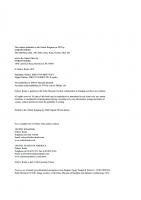
- Author / Uploaded
- Sir W.M. Flinders Petrie
File loading please wait...
Citation preview
Oxford & Philadelphia
This edition published in the United Kingdom in 2023 by OXBOW BOOKS The Old Music Hall, 106–108 Cowley Road, Oxford, OX4 1JE and in the United States by OXBOW BOOKS 1950 Lawrence Road, Havertown, PA 19083 © Oxbow Books 2023 Paperback Edition: ISBN 979-8-88857-020-3 Digital Edition: ISBN 979-8-88857-021-0 (epub) First published in 1896 by Bernard Quaritch Facsimile edition published in 1974 by Aris & Phillips Ltd Oxbow Books is grateful to the Petrie Museum for their collaboration in bringing out these new editions All rights reserved. No part of this book may be reproduced or transmitted in any form or by any means, electronic or mechanical including photocopying, recording or by any information storage and retrieval system, without permission from the publisher in writing.
Printed in the United Kingdom by CMP Digital Print Solutions
For a complete list of Oxbow titles, please contact: United Kingdom Oxbow Books Telephone (0)1226 734350 Email: [email protected] www.oxbowbooks.com United States of America Oxbow Books Telephone (610) 853-9131, Fax (610) 853-9146 Email: [email protected] www.casemateacademic.com/oxbow Oxbow Books is part of the Casemate Group
Front cover: Ceramic jar with painted decoration. From Naqada, Egypt, Naqada II Period (c. 3500–3200 BC). Petrie Museum UC4326. Image courtesy of the Petrie Museum of Egyptian and Sudanese Archaeology, UCL.
vi
PREFACE TO THE 2023 EDITION In the 1970s, a much-anticipated new series of publications illustrated objects and themes related to the excavations of the archaeologist William Matthew Flinders Petrie (1853–1942) in Egypt, and aspects of the collection of University College London’s Petrie Museum of Egyptian and Sudanese Archaeology. A young couple setting up in business in the early 1970s, Aris and Phillips published these works, written by members of the UCL Egyptology Department, in their Modern Egyptology series. Building on Petrie’s own observations, the authors of these volumes aimed to complete the great task of publishing the Petrie Museum of Egyptian and Sudanese Archaeology’s vast collection, and to present some of the research that Petrie himself was not able to address in his own published works during his lifetime. As the current Curator of the Petrie Museum, it is a great privilege for me to support Oxbow Books in their mission to republish the series, which remains a key source of information for all those interested in object-based approaches to the study of the ancient world. The Petrie Museum, part of University College London (UCL), is home to one of the largest and most significant collections of Egyptian and Sudanese archaeology in the world. Free to visit, this extraordinary collection tells stories about the lives of ordinary people who lived along the Nile Valley thousands of years ago. Originally set up as a teaching collection, the Petrie Museum comprises over 80,000 objects housed together with an internationally important archaeological archive. It is a collection of world firsts and ‘oldests’: the oldest woven garment; the oldest worked iron objects; the first known depiction of loom weaving; the oldest known written document about women’s health; the earliest veterinary treatise; the oldest will on paper. The Museum has Designated Status from Arts Council England, meaning that it is considered to have outstanding resonance and national cultural significance. The collection has a substantial, visible international reputation for research, supporting hundreds of researchers every year, both remotely and in person. The Petrie Museum is named after Flinders Petrie, who was appointed in 1892 as the first Professor of Egyptian Archaeology and Philology in the UK at UCL. Over three-quarters of the material in the Museum comes from excavations directed or funded by Petrie, or from purchases he made for university teaching. In 1880 at
the age of 26, Petrie travelled to Egypt to survey the Great Pyramid. For the next five decades he was at the forefront of the development of archaeology in Egypt and later in Palestine, and his detailed methodological approach continues to shape the discipline today. Petrie worked at more sites, with greater speed, than any modern archaeologist: seeing his life as a mission of rescue archaeology, Petrie aimed to retrieve as much information as possible from sites that were shrinking dramatically in size as Egypt modernised during the late 19th and early 20th centuries. He published a large part, but not all, of the finds from his excavations in his illustrated typological volumes, arranged according to object types and themes. Today, much of the Petrie Museum’s collection is displayed and stored in a way which reflects these publications: for example, several storage cupboards are dedicated to the material illustrated in the ‘Objects of Daily Use’ volume, and objects in the drawers are arranged according to the order of the published plates. This offers a unique opportunity for researchers to engage with Petrie’s typological and methodical approach to archaeology, as well as with the history of museum collections. The first catalogue to be published in the Modern Egyptology series was Amarna: City of Akhenaten and Nefertiti in 1972 by Julia Samson, Petrie Museum Honorary Research Assistant. As official publishers to the UCL Egyptology Department the series went on to produce facsimile reprints of eight of Flinders Petrie’s most important site reports and many of his object catalogues, originally published through the British School of Archaeology in Egypt. The substantial annual royalties from these reprints were paid into the ‘Petrie Fund’ at the time, which provided special grants to students in financial need. In many ways, the new reprints of this classic series can be seen as the latest layer in a vast ‘publication stratigraphy’ of the thousands of finds from Flinders Petrie’s excavations, which now live in museum collections around the world. On reading these volumes, I hope that readers will also be inspired to learn more about the Petrie Museum collection and its fascinating history. Dr Anna Garnett Petrie Museum of Egyptian and Sudanese Archaeology, University College London January 2023 xi
PUBLISHER’S PREFACE Oxbow Books is pleased to present this title in our Classics in Egyptology series. This series of facsimile re-issues is comprised of two sub-series. The first consists of 16 typological catalogues produced by W.M. Flinders Petrie based on his massive collection of Egyptian artefacts. Mostly excavated by Petrie during many seasons of campaign in the last years of the 19th and early decades of the 20th century, they now reside in the Petrie Museum at University College London. Published between 1898 and 1937 and long out of print, the catalogues were re-issued in facsimile by publishers Aris and Phillips in the 1970s. These were followed in the next 15 years or so by publication of a number of newly commissioned titles, based on more recent examination of elements of the Petrie Collection by contemporary experts, under the name Modern Egyptology. A selection of these additional titles forms the second component of our own series. The archaeology of Egypt continues to fascinate. Multi-disciplinary investigation and research continues unabated, encompassing methodologies, scientific and data processing techniques, theoretical approaches, and even whole paradigms that were unheard of in the 1970s and undreamt of when Petrie was working in Egypt. Yet all the titles included in this series continue to be invaluable sources of basic data, providing an unparalleled resource that can easily be cross- referenced with the actual materials they describe and discuss. They remain within the Petrie Collection where they may be accessed and re-examined as new research flourishes. As historic documents, the Petrie
xii
catalogues stand as exemplars of the craft of typological classification, the backbone of modern archaeology – much of which, though refined by absolute dating and another 100 years of research, still stands the test of time.
A note on presentation The facsimile titles of Petrie’s catalogues re-issued in the 1970s were produced from scans of the original publications. Scanning technology at that time was not of the standard or resolution of today. The scans are no longer available, nor has it been possible to obtain, and in doing so destroy, original copies of the Petrie catalogues. These titles have therefore, of necessity, been rescanned from the 1970s re-issues. Where necessary the pages have been digitally enhanced for clarity of reading and to ensure the good quality of the plates, though inevitably a few are not of the standard we might wish, because of the quality of the previous scan, and occasional blocks of text are not precisely ‘straight’ or evenly situated on the page. However, some pages in the 1970s re-issues had been inserted in the wrong order and this has been corrected. The originals were produced at a folio size. The pages have been reduced slightly to standard A4 for ease of shelving and because this has the effect of slightly improving the scanned images. In some cases, illustrations were presented to scale and the original scale is given on the plate. There were also no digital files available for titles included in the Modern Egyptology series, so these too have been scanned from printed copies.
